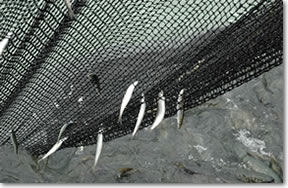Prince William Sound, Alaska 2006 herring announcement
10/05/06Cordova, Alaska
Based on current herring stock assessment information, the 2006-2007 food and bait fishery and all 2007 spring herring fisheries including the purse seine and gillnet sac roe harvests, the spawn-on-kelp in pound fishery, and the wild spawn-on-kelp harvest are closed. The Prince William Sound herring biomass estimate is below the minimum spawning biomass threshold of 22,000 tons. According to 5AAC 27.365(b) Prince William Sound herring management plan, no fishery may be opened if the estimated spawning biomass is below this threshold level.

Age Structured Assessment modeling was used to project the 2007 biomass of Pacific herring. The PWS herring biomass forecast for 2007 is 15,830 tons. Hydroacoustic, net sampling, and aerial surveys were conducted in 2006 to assess herring biomass, disease prevalence, age composition, and growth.
Acoustic surveys were conducted with the ADF&G R/V Solstice and the F/V Kyle David, contracted by the Prince William Sound Science Center, during the last week of March, 2006. Broad scale sonar surveys were conducted in eastern Prince William Sound up to Valdez, the Naked Island archipelago, western Knight Island bays (including Mummy Bay to Point Helen), northern Prince of Wales Passage, Sawmill Bay, and north and central Montague Island. Detailed acoustics data were collected on major concentrations of herring in the St. Matthews Bay to Red Head area and in Sawmill Bay. Preliminary analysis of that data has not yet been completed. Age compositions from acoustics survey samples were 91% age-2 and 8% age-3 herring in Sawmill Bay on 12 March, and 22% age-2, 29% age-3, and 18% age-4 herring in Olsen Bay on 22 March.
Spawning samples were collected from late March through mid-April. Two samples were collected from Hell's Hole, and one sample each from Snug Corner Cove and Landlocked Bay. Age composition samples were 67% age 7 on 26 March and 70% age 7 on 27 March in Hell's Hole, 53% age 7 in Snug Corner Cove on 27 March, and 37% age 6 and 29% age 7 in Landlocked Bay on 14 April.
Herring disease assessment has been included as part of the annual age, sex, and size assessment the department has completed each spring since 1993. In March and April, the department examined herring for prevalence of focal skin reddening and the pathogen Ichthyophonus hoferi. Prevalence of focal skin reddening associated with viral hemorrhagic septicemia virus (VHSV) was low; however, prevalence of I. hoferi was high (25%) and is consistent with the increasing age of the predominant 1999 age class. If this trend continues, mortality of the predominant age class may increase significantly. The department will continue to monitor these disease indices this spring.
Aerial surveys documented a peak biomass estimate of 540 tons of herring versus 4,773 tons in 2005 and 12,305 tons in 2004. An estimated total of 642 tons of herring were seen throughout PWS, with the largest estimates being 210 tons in Port Gravina, 235 tons in the Port Fidalgo area, and 135 tons in the Tatitlek area. A total of 22.4 mile-days of spawn were observed in spring 2006, which is the third lowest since 1973. The largest spawning events occurred in Port Gravina and Port Fidalgo, with twelve miles of spawn and eight miles of spawn respectively. Additional spawn was documented in the Simpson and Sheep Bay area, in the Tatitlek area, and in Stockdale Harbor on Montague Island.
The department will collect additional age, sex, and size data along with disease information throughout PWS this fall. Additional updates on the status of the PWS herring population will be announced when new information becomes available.
From Alaska Department of Fish and Game Press Release

